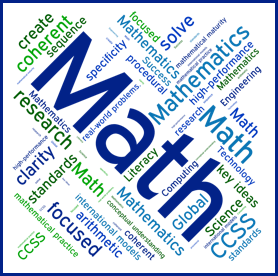
 |
The following assessment will be covering the following standards:
STANDARD DESCRIPTION |
ACADEMIC VOCABULARY |
RESOURCES |
| 8.NS.A.1 Know that there are numbers that are not rational, and approximate them by rational numbers. 8.NS.1 Know that real numbers are either rational or irrational. Understand informally that every number has a decimal expansion which is repeating, terminating, or is not-repeating and non-terminating. |
rational number, repeating decimal, terminating decimal, irrational number, perfect square, real numbers, square root | Pearson Digits Program AIR Practice Questions Khan Academy Kuta Software |
| 8.NS.A.2 Use rational approximations of irrational numbers to compare the size of irrational numbers, locate them approximately on a number line diagram, and estimate the value of expressions (e.g., π2 ). For example, by truncating the decimal expansion of √2, show that √2 is between 1 and 2, then between 1.4 and 1.5, and explain how to continue on to get better approximations. | rational number, repeating decimal, terminating decimal, irrational number, perfect square, real numbers, square root | Pearson Digits Program AIR Practice Questions Khan Academy Kuta Software |
| 8.EE.C.7 Solve linear equations in one variable. a. Give examples of linear equations in one variable with one solution, infinitely many solutions, or no solutions. Show which of these possibilities is the case by successively transforming the given equation into simpler forms, until an equivalent equation of the form x = a, a = a, or a = b results (where a and b are different numbers). | isolate, like terms, Distributive Property, least common multiple, no solution, infinitely many solutions
|
Pearson Digits Program AIR Practice Questions Khan Academy Kuta Software |
| 8.EE.C.7b Solve linear equations with rational number coefficients, including equations whose solutions require expanding expressions using the distributive property and collecting like terms. | perfect square, square root, perfect cube, cube root, power of a power, power of a product, power of a quotient, Zero Exponent Property, Negative Exponent Property scientific notation, standard form | Pearson Digits Program AIR Practice Questions Khan Academy Kuta Software
|
| 8.EE.A1 Know and apply the properties of integer exponents to generate equivalent numerical expressions. For example, 32 × 3–5 = 3–3 = 1/33 = 1/27. 8.EE.A2 Use square root and cube root symbols to represent solutions to equations of the form x2 = p and x3 = p, where p is a positive rational number. Evaluate square roots of small perfect |
perfect square, square root, perfect cube, cube root, power of a power, power of a product, power of a quotient, Zero Exponent Property, Negative Exponent Property scientific notation, standard form | Pearson Digits Program AIR Practice Questions Khan Academy Kuta Software
|
Please read the following before you begin:
1.) To avoid losing any work, make sure you click the SAVE button after each question.
2.) When you are finished with your assessment, click ALL FINISHED! REVIEW MY ANSWERS.
3.) When you are satisfied with your work, click LOOKS OK! SEND TO MY TEACHER.